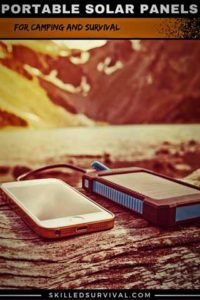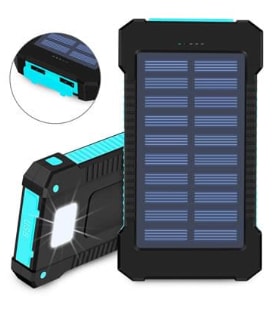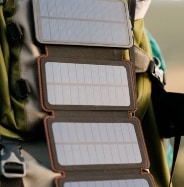Looking For A Portable Solar Charger For Your Next Great Adventure?
You’re in the right place.
You see, there’s been a recent boom in portable solar phone chargers.
And their increasing popularity has taken the world by storm.
Why? Because they’re so incredibly useful for everyday needs, wilderness adventures, and emergencies.
These portable devices turn solar energy from the sun into usable electrical power.
Energy to power all your electronic devices while on the go.
Everyday carry gear such as:
- Smartphones
- Tablets
- Cameras
- GPS units
- Flashlights
- Headlamps
- Rechargeable batteries
- Etc.
The key here is the portability of these solar chargers.
People have been installing large solar panel systems for years. And the market for solar generators has also been on the rise recently as well.
And while these systems are no doubt powerful, they are not mobile.
That’s why the latest portable solar chargers are so exciting.
They allow you to harness the sun’s power with a device that fits in your backpack or pocket!
So today, I’m going to discuss the following topics:
-
Best Portable Solar Chargers For Camping and Survival
-
The Benefits Of Owning A Portable Solar Charger
-
Who Are Portable Solar Chargers For?
-
Best Portable Solar Setups
-
Pros/Cons Of Portable Solar Chargers
Are You Ready For The Tough Times Ahead? Take My 60 Sec Quiz To See If You’re Part Of ‘The Fragile Masses’ Or Not… Start Quiz Now!
Best Portable Solar Chargers For Camping & Survival
Here are a few of the best portable solar chargers we’ve used and own.
Evatac – Gear For Tactical Minds: Anytime Charge
Skilled Survival highly recommends the Anytime Charge Solar Power Bank.
Why? Because it’s one of the most durable, compact, and cost-effective portable solar chargers on the market today. But don’t let its compact size fool you; it’s also got a massive 10,000 mAh battery capacity!
That’s enough battery storage to charge any device multiple times over. Plus, with dual charging outputs, you can power multiple devices simultaneously!
Plug in your devices via the supplied USB cable (you can use any USB cable) and press the power button. Your device will begin to take power from the Anytime Charge right away.
Recharging the Anytime Solar Bank couldn’t be easier – leave it in the sun, and it will automatically fill the large battery bank ANYWHERE.
Plus, it’s splash resistant and comes with an emergency flashlight with a strobe function.
NOTE: When this article was published, you could snag some bonus Tactical Flashlights For FREE when you buy multiple Anytime Solar Chargers. Click below to see if this deal is still available!
Portable Solar Power Bank!
QuadraPro Solar Power Bank with Wireless & Dual USB Charging
The QuadraPro Dual USB Power Bank is a quality solar bank by Survival Frog.
It’s got a huge 6,500mAH battery capacity with dual charging ability.
It’s also rugged, splash-resistant, and ultra-compact – ideal features for any everyday carry or outdoor adventure.
For example, The QuadraPro comes ready to go out of the box!
The slim design means you can slip this power source into your pocket or backpack to have power while you’re on the go!
Survival Frog QuadraPro Wireless Solar Power Bank Review
Goal Zero Guide 10 Plus Solar Recharging Kit with Nomad 7 Solar Panel
The Goal Zero Guide 10 Plus Kit is a polished setup with two major parts.
1 – The Guide 10 Power Pack
2 – The Nomad 7 Solar Panel
The Nomad 7 solar panel is a compact small 9″x7″ X1.5″ unit.
It weighs in at about 13 ounces.
That’s slightly heavier than some other comparable units. But that’s offset by extra features and much more durability than the competitors.
First off, the two solar panels are well protected in robust nylon housing.
It folds up with magnet closures and has many attachment points to secure the unit.
This makes it easy to hang it outside your pack or clip it to a chair in camp.
Another nice touch on the back of the panel is a zippered cable management pocket.
Opening it up, you find several options for connecting your devices.
A standard USB outlet provides up to 5V/1A straight to your phone, tablet, or anything else with a USB cord. Next to that, there’s a 12V “Solar Port,” which allows you to plug in a car adapter.
Finally, a “Mini Solar Port” plugs into a wide array of Goal Zero products. There’s also a Mini Solar Port input – which allows you to chain together several panels for more power.
The accompanying Guide 10 power pack is more than just a simple battery pack.
It’s a compact battery charger with some nice features. It accepts four rechargeable AA batteries that pop right into the unit for charging.
Once they’re topped off, you can use them in anything with AA batteries. Then pop in four more rechargeable AAs to keep the energy production going.
There’s also an adapter to fit AAA batteries, so if you find you use more of those, that will come in handy.
My headlamps nearly all use AAA batteries, so I’ll get a lot of use from this.
Guide 10 also includes a small white LED bulb. So you can use it as an emergency flashlight or for quick light inside the tent at night.
It’s enough light to adjust your sleeping bag, find something you dropped, or open the tent flap to get out. And it’ll last over 100 hours on one charge.
If Goal Zero price is a concern, look for an integrated battery solar charger instead (which we just covered above).
Integrated chargers are battery/panel in one-piece units. So there’s nothing left behind and no cords to snag or break.
They’re often more rugged than folding systems too. But they often have less efficient cells. And they require more sunlight to charge a comparable amount of energy.
As with most things, there are always tradeoffs, but you tend to get what you pay for.
Portable Solar Panels – Goal Zero Guide 10 Plus Solar Recharge Kit Review
***The Goal Zero Guide 10 Plus Solar Kit giveaway mentioned in the video has ended.***
Benefits Of Owning A Portable Solar Charger
Portable Power
It’s power on the go.
You need one if you enjoy camping, hiking, hunting, or any outdoor adventure.
That way, you can keep all your small electronic devices charged and at the ready, just in case. Whether it’s to call a loved one, stay on track with a GPS device, or charge some batteries for your flashlight.
Plus, the benefit of charging a phone without a charger in an emergency.
“Free” Power
Portable solar chargers cost more than a few packs of batteries, but it’s a one-time investment.
An investment that will easily pay itself off over time.
After the initial investment, you can charge your devices anywhere for ‘FREE.’
Backup Power
If you’re a regular visitor of Skilled Survival, you’ve thought about backup power.
If you haven’t, now is the time!
All your battery devices have a countdown timer when the power grid goes down. Once the battery hits zero, it becomes an expensive paperweight until the power returns.
All your survival books on hunting and foraging…you know, the ones saved to your tablet? Gone.
The full-color step-by-step survival guides on your laptop? The ones detailing how to build everything from a single-night shelter to a full log cabin?
Lost without power.
And while GPS satellites will continue to send data, it doesn’t matter if your GPS devices are dead.
Solar chargers are the perfect backup power solution for small electronic devices.
But why should you invest in a portable solar charger and not an extensive roof solar array/battery bank system?
First off, large rooftop solar systems are great. So are large solar power stations.
If you can afford to add solar panels to your home or to get completely off the grid, DO IT! But they’re not portable.
So it’s a good idea to invest in a smaller-scale power generation tool for your everyday carry devices.
As A Way To Introduce You To Skilled Survival, We’re Giving Away Our Ultimate Camping Essentials Checklist. Click Here To Get Your FREE Copy Of It.
Who Should Own A Portable Solar Charger?
Campers and Backpackers
Portable solar charges are great for camping on remote sites or in the comforts of a state park.
You’ve undoubtedly come across times when you’re getting low on power at either location.
Charging up the camera for a few more photos or boosting the GPS for you to follow your trail out is a great option.
And as portable solar chargers get smaller and more efficient, you’ll hardly notice it in your pack!
Solar chargers are quickly becoming essential gear for camping.
Hunters and Fishermen
Most hunters and fishermen carry cell phones and flashlights into the field.
They increasingly carry camera equipment, rangefinders, GPS devices, and night vision goggles. These electronics add up to a lot of spare batteries.
A portable solar charger can take advantage of downtime during the day to keep these devices topped off.
Backcountry Travelers and Emergency Situations
Every winter, we hear stories of a family outing turning deadly.
When someone blindly follows a seasonal road and finds themselves stuck in cold weather.
These people often used their vehicle’s batteries to keep warm.
However, eventually, even their vehicle batteries will die. And their cell phones start dwindling along with their chances of rescue.
Using a portable solar charger to gain a few minutes of cell phone power can be enough to send an emergency text.
It can also help ping a cell tower, giving searchers a general search area to focus on.
Best Portable Solar Charger Setups
I own all three portable solar charger models (the ones reviewed above).
Two have an internal power pack, and one is paired with an external battery pack.
I use them differently for different reasons.
Shorter Trips – Internal
The internal battery systems are best for short-duration trips. Ones where I won’t need more than one night’s worth of light or a partial GPS charge.
Enough power to find my way back to the truck, transverse backcountry mountain trails, or navigate an afternoon canoe trip.
These small solar chargers are lighter and take up less space in my pack than larger units making them excellent choices for “get home” bags, bug-out bags, or survival kits.
Longer Trips – External
For longer trips, I turn to the external battery model. These allow me to use one battery pack while I charge a second.
This setup is larger and bulkier. But along with the weight increase, you’ll also get more power generation.
Instead of trying to power your devices directly with this setup, you’ll use the portable solar panels to power an external battery bank.
Charging a battery pack in this way allows you to set up the charger in the most convenient location. And this prevents you from being tethered to it at all times.
With the GoalZero Kit above, an external battery bank was provided. However, this is not always the case.
Purchasing An External Battery Bank
If you purchase a portable solar panel that doesn’t come with an external battery, then you should buy one.
Many companies make USB battery packs. But, I prefer the most capacity for my dollar. These are usually generic and off-brand battery packs.
Look for ones with a capacity of at least 10,000mAh and a price of around $25. It should have one 2.1A or higher outlet for fast charging; a few extra outlets are always useful.
For example, The Anker PowerCore 10000 Portable Charger fits the bill.
The other bonus of charging battery packs (besides pure storage) is managing the variability of incoming solar power.
Yes, most battery packs will accept a wide variety of incoming voltages. But “smart” devices are more restrictive on the incoming voltages.
This steady power requirement is to protect the internal circuits. But this built-in device protection makes direct solar charging challenging.
For example, voltage variations trick my phone into disconnecting.
This issue happens whenever a cloud passes overhead OR sometimes for no apparent reason.
So it’s better to charge a battery pack first and then use the stored power to charge your devices.
This setup allows you to buffer out those pesky variations.
Thus, providing steady and consistent power to your devices.
As A Way To Introduce You To Skilled Survival, We’re Giving Away Our
Ultimate Survival Gear Checklist. Click Here To Get Your FREE Copy Of It.
Pros & Cons Of Portable Solar Chargers
As with any device, there are pros and cons to owning one. So let’s cover the advantages first and then discuss a few challenges.
PROS
- No Fuel
- No Trace Left Behind
- Silent
- Modular
- Lightweight
Let’s dive into each of these in more detail.
No fuel Needed
<a href="https://www.skilledsurvival.com/campstove2+" target="_blank" rel="nofollow sponsored noopener" data-lasso-id="20233" data-lasso-name="BioLite CampStove 2+











